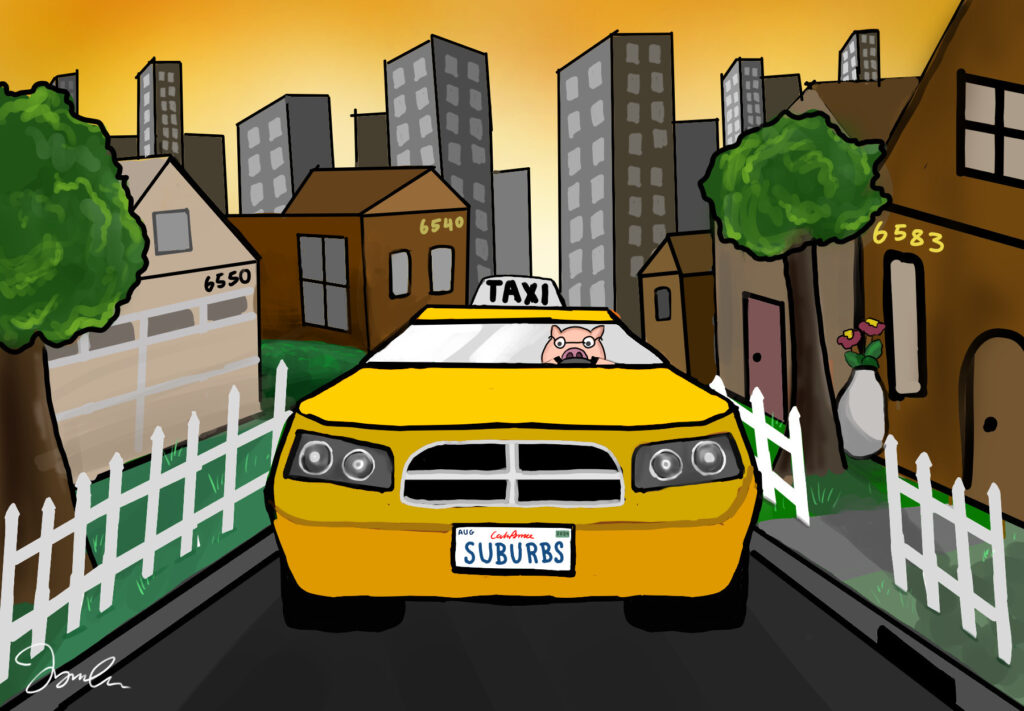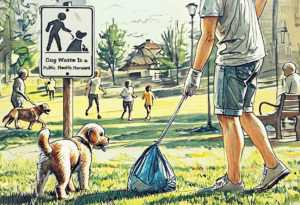
Growing up in the East Bay Area, I remember taking the occasional hour-long trip to larger urban cities such as Oakland and San Francisco. Whether that was to explore the Oakland Zoo, hunt around art stores, or visit Chinatown, the congested traffic and dirty air always stood out to me. Naturally, I always thought the suburbs with leafy trees, lush parks, and unpolluted air where I lived were much more sustainable for the environment. Little known, however, is that our quaint suburban neighborhoods may be competing with the gas-guzzling streets of New York City.
What is Suburban Sprawl?
Suburban Sprawl is the wild and inefficient expansion of suburban housing. This development begins in urban cores but gradually encroaches on neighboring rural areas. These are often large, low-density living spaces that are distant from the centers of metropolitan cities.
Industrial Roots
Beginning with the industrial revolution in the late 1980s, suburban sprawl in the U.S. has become highly prominent. An interactive map named Built: L.A., created by Omar Ureta, an urban designer, shows significant housing expansion from the core of Los Angeles, California, to surrounding suburban cities such as Inglewood, Compton, and Beverly Hills between 1900 and 1940.
Urbanization, housing markets, and advancements in transportation in the early 1900s led to mass migration to urban cities such as Los Angeles and New York. With this influx of people, the development of housing, and the popularity of the private automobile, suburban neighborhoods gradually encroached on surrounding agricultural land.
Geographical Patterns of Carbon Emissions
With the increase in the prevalence of urban sprawl across the 20th century, positively correlated with global economic and population growth, concerns with expansive housing development have arisen in the past decades. The sustainability of suburbs has become highly questioned. Studies have shown suburbs to exhibit more household carbon emissions than urban cores, and “population density exhibits a weak but positive correlation with [Household Carbon Footprint] until a density threshold is met, after which range, mean, and standard deviation of HCF decline” (Jones, Kammen). High populations in compact cities are not significant contributors to household emission levels, and the suburbs emit more carbon emissions while housing a much lower population than urban cities on average. In fact, doubling the population density in urban areas reduces carbon emissions from transportation by 48% and residential energy use by 35%.
Illustrated by LibreTexts GeoSciences in a comparison between Atlanta and Barcelona, sprawling cities consume more energy on average despite similar population numbers.
An interactive map of California’s geographic carbon footprint levels shows that in 2020, the average household in San Francisco and Oakland, two major urban cities in California, produced around 10 to 40 metric tons of carbon emissions.
Meanwhile, the average household in San Ramon, a suburb in the East Bay Area, 40 miles from San Francisco, produced 40 to >60 metric tons of carbon emissions.
According to the U.S. Census Bureau, between 2017 and 2021, the average number of people per household was 2.34 in San Francisco, 2.58 in Oakland, and 2.94 in San Ramon. With minimal deviation from the average household population, an up to a six-fold increase in suburban household carbon emissions compared to its urban counterpart is shocking.
The same map demonstrates relatively low-carbon emission urban cores such as New York City, Philadelphia, and Washington D.C., surrounded by carbon-intensive suburbs that exhibit up to three or four times the carbon emission levels in major urban cities. Such a disparity between both areas begs the question: Why are suburbs exhibiting such extreme pollution levels?
Employment Density and Transportation
My father used to work in San Francisco, and every morning, he would take the San Mateo-Hayward bridge across the Bay to commute to his job. In urban cities, the workplace is a short walk, bike ride, or bus ride away for many. For suburban workers, however, commutes are often far and located in major urban cities. A map demonstrating employment density in and around Houston, Texas, shows a significant concentration of overall jobs in the heart of Houston than in its surrounding suburbs.
Another map of Northern California’s job density shows great employment concentration in the urban cores of San Francisco, Oakland, and San Jose.
With job concentration located in the heart of urban cities and sprawling houses growing increasingly distant, the use of cars across long distances for work has become prominent. 76% of Americans use their car to commute to work. Given the disparities in geographical employment trends, it is not shocking that most car ownership is concentrated in the suburbs. According to data reports by Vanderbilt University, “Car-free households are generally much more common in densely-populated urban areas.” Data conveys that while 30% of San Francisco, California households did not own a car in 2016, that percentage ranged from ~2% to 6% in the surrounding suburbs of San Diego, Hayward, and Elk Grove. In New York City, New York, 54% of households had no car ownership, while that number dropped to ~23% to 29% in the surrounding suburbs of Buffalo, Syracuse, and Yonkers.
Access to public transportation in urban cities contributes to decreasing carbon emissions. Carbon emissions decrease by 45% when taking public transportation instead of driving alone. With suburban residents living further away from jobs, schools, and grocery stores, it is no wonder a study reveals that “suburban households drive 31 percent more than their urban counterparts” (Khan, 2000).
Given the extensive data on transportation differences between urban cores and suburban sprawls, driving distances and employment density are significant reasons for the disparity between carbon emissions in population-dense cities and the suburbs.
Residential Energy Consumption
While prolific, Suburban transportation is not the sole blame for high carbon emission levels in respective areas. Residential electricity consumption from heating and cooling between suburban and urban areas also differs significantly. As an EPA study shares, “Multifamily and single-family attached homes generally have smaller square footage per unit and shared walls, thus requiring less energy for heating and cooling than their detached counterparts” (Hernandez et al., 2011). Single-family attached and multifamily homes also produce 10,680 and 6,480 pounds of carbon dioxide per year, respectively, while single-family detached homes produce 12,960 pounds of carbon dioxide annually.
With American homes contributing 441 million tons of carbon dioxide each year solely due to household heating and cooling, it is crucial to consider the energy efficiency of temperature control in suburban houses and its contributions to excessive energy consumption.
Consequences
The environmental detriments of suburban sprawl remain increasingly prevalent as housing development continues to streamline. Fossil fuels are responsible for 75% of global greenhouse gas emissions and 90% of all carbon emissions. With cars and trucks accounting for almost a fifth of all U.S. emissions and household energy consumption accounting for about 20%, suburban growth becomes wildly inefficient and unsustainable, significantly contributing to transportation and household energy consumption.
Agricultural land and wild habitats are disappearing at a steady rate. Since 1982, the U.S. has lost 31 million acres of agricultural land. If land space is limited, why not use it better? Referring to the figures previously mentioned, why are 2.5 million people living in 1,650 square miles of the Atlanta region? Lifestyle affordability aside, it is heavily due to suburban sprawl.
The suburban lifestyle reinforces a dependency on unsustainable habits like driving often and occupying unnecessary space for comfort and luxury. Living in a quiet little suburbia easily slips under the radar in the investigation to combat contributors to unsustainability. While factors such as increasing personal wealth and population influx are challenges to greener residential development, new methods and ideas among urban developers, politicians, and community advocates have arisen to combat inefficient sprawling cities.
Solutions
Resolutions to such a deeply-rooted issue take time and effort. Ideas such as moving the entirety of America’s population to compact and uniform cities easily walkable with evenly spread employment densities are unreasonable. It is important to remember that urban cities are not leaps and bounds beyond suburban detriments to the environment. Between light pollution, air pollution, congestion, and sanitation, urban life, while driving less and living more compact, has its environmental downfalls. The reality is that housing is an environmental liability and is rarely, if ever, completely sustainable. However, regaining control over suburban sprawl and constructing living areas more environmentally consciously for efficiency is a step in solving the many problems facing housing in America and around the globe.
Smart Growth
A key characteristic of suburban sprawl is wild and unplanned growth, hence the importance of creating smarter suburban designs in growing cities. Residential areas mixed with transit-oriented development with well-created pedestrian walkways, abundant employment opportunities, and efficient public transport are aspects of a smart-growing suburban city. Better yet, smart-growing cities are desirable. An EPA study of housing desirability comparing smart-growth suburban developments and conventional suburban developments finds that, more often than not, smart-growth developments show higher resale appreciation than their conventional counterpart. Smart growth developments in sprawling cities have started in infamous sprawling cities such as Atlanta. According to the Georgian Encyclopedia, “The Atlanta Beltline, an ambitious transit corridor scheduled to circle the city by 2030, increases transportation options for Atlantans by linking intown neighborhoods with pedestrian and bicycle paths and creates development opportunities along the path’s projected twenty-two-mile perimeter” (Kundell and Myszewski, 2002).
New Urbanism
With inner cities often being cited as dilapidated and dirty with crumbling infrastructure, the new housing development away from urban cores can sound enticing. Rather than escaping inner-city slums by moving increasingly further into the suburbs, invest in the resurgence and revitalization of urban centers, communities, and local economies. General cleaning of polluted areas and repairs in dilapidated infrastructure in a new urbanism agenda can help reduce the likelihood of sprawl.
Residential Efficiency
Given its environmental impact in the suburbs, closely following the impacts of transportation, inefficient residential energy use is essential to address. Habits like using your thermostat sparingly, sealing windows, installing heat pumps, insulation, and solar panels, shutting off unused devices, unplugging unused chargers, and replacing incandescent lightbulbs with LED lightbulbs all contribute to decreased consumption of residential energy use and fewer carbon emissions.
Suburban Microtransit
While public transportation such as the metro station, BART, and buses are effective means of shared rides, the set stops and fixed routes can limit passengers. Microtransit shared riding is a way for passengers to navigate in spaces between fixed public transportation routes. Microtransit programs have already begun in many cities, such as SmaRT Ride in Sacramento, which allows door-to-door rides, costing the same as traditional public transportation, and míocar in the San Joaquin Valley. With the rise of microtransit and more flexible mobility of shared transportation, suburban commutes can become more carbon efficient. A study of microtransit impacts reveals that “more than 40% of riders said that, without SmaRT Ride, they would have made their last microtransit trip by car instead. This suggests that microtransit has real potential to reduce dependence on driving” (Xing et al., 2022).
Spreading Awareness
One of the most critical actions to address suburban sprawl is simply spreading the information. Before stumbling upon the concept of suburban sprawl, I had yet to learn of its existence and environmental impact. Many people have an existing misconception that cities and farms are the epitomai of carbon pollution and unsustainability. Moreover, while both cities and farms have their environmental harms, the suburbs are often left out of the conversation. Between writing and researching for this article, I often brought up revelations and statistics to friends and family, who were unaware of the sheer detriments of a suburban lifestyle. As a community, proposing and supporting ideas for our households, city improvement programs, local construction planning, and talking to those in our suburban communities are all steps to spreading awareness and creating change.
The views and opinions expressed are those of the authors and do not necessarily reflect nor represent the Earth Chronicles and its editorial board.




